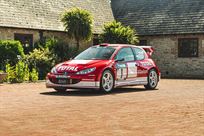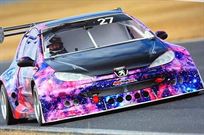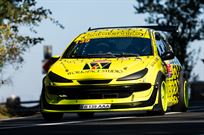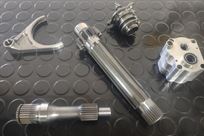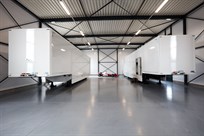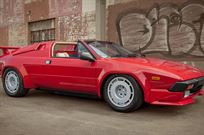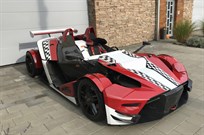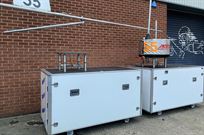Race Cars

£ POA
2001 Peugeot 206 WRC Evo 2
Description:
Highlights
Winner of three World Rally Championship events: Rally Australia and the Tour de Corse in 2002 and Rally New Zealand in 2003
A Works Peugeot Sport entry in 10 rounds spanning three seasons of the World Rally Championship, as verified by its original FIA Gold Book
Raced by three World Rally Champions: Marcus Grönholm, Didier Auriol and Richard Burns
Campaigned by the double World Rally Champion Marcus Grönholm during his second championship-winning season
Recently restored to the exact configuration and livery in which its triumphed in New Zealand, chassis C35 is accompanied by an extensive history file
Accompanied by a generous history file comprising a wealth of event-specific documentation for the three World Rally Championship rounds in which this Peugeot triumphed
The Peugeot 206 WRC
The towering concrete overpass and the grassy banks either side of the structure are jam-packed with thousands of people, many of whom wave Spanish flags and banners. Ripples of buoyant, feverish excitement erupt with each and every car that storms towards and negotiates the tight left-hand hairpin, especially the compact Peugeot 206 WRCs, which cock their inside rear wheels as they pass like excitable puppies.
This single corner at Rallye de España in 2002 encapsulates the wild popularity of the rallying around the turn of the Millennium. It was reminiscent of the halcyon days of Group B in the 1980s, when a similarly diverse plethora of manufacturers had flocked to the World Rally Championship. And Peugeot’s ‘Silver Bullets’ were front and centre. Not only did they return the title to the French marque for the first time since the 205 T16 managed the same feat in 1985 and ’86, but they also went one better, snatching the crown three times in a row, from 2000 to 2002.
Unlike the large, boxy and practical saloons such as the Subaru Impreza and the Mitsubishi Lancer Evos which had become commonplace (and dominant), the comparatively dinky Peugeot 206 was an entirely different proposition – compact, curvaceous and as nimble as a fly, with all four wheels right at the corners
If its Group B forebear, the 205 T16, was a caveman’s club, the 206 WRC was a surgeon’s scalpel. The circular plastic door handles and the headlight surrounds were all that were carried over from the road-going 206, Peugeot exploiting the FIA’s relatively relaxed rules and, of course, the fact it wasn’t required to build a costly homologation special for the road.
For such a little car, the 206 WRC was crammed with state-of-the-art technology, from the suite of electronic systems including those which controlled the differentials to the unusual longitudinally-mounted gearbox behind the transverse turbocharged two-litre engine. Peugeot even developed its own shock absorbers. It was this research and development that equipped the 206 with a freakish breadth of ability and, ultimately, the edge over its rivals.
Peugeot Sport No. C35
Stamped with the internal Peugeot Sport chassis number C35 and assigned the French registration ‘286 NNN 75’, the 206 WRC Evo 2 we’re pumped to be offering is one of 21 examples built to Evo 2 specifications. That meant a more powerful engine and a wheelbase subtly modified for greater agility (as if the original car needed it).
A Works Peugeot Total World Rally Team entry, chassis C35 made its competitive debut at Rally Cyprus in June of 2001, in the hands of the then-reigning World Rally Champion Marcus Grönholm alongside his co-driver Timo Rautiainen. The duo’s tally of three special stage victories was agonizingly thwarted by a mechanical failure.
The perilous ‘yumps’ and knee-deep gravel of Finland were next for chassis C35, which this time around was driven by the 1994 World Rally Champion Didier Auriol. The 45th Tour de Corse in October of 2001 was when this Peugeot really hit its stride. A new driver pairing was once again assigned, this time the French brothers Gilles and Herve Panizzi. They lived up their billing as the ‘Kings of Tarmac’, clinching six special stage victories and finishing second overall.
As Panizzi narrowly missed out on victory in Corsica, so he was afforded a second bite of the apple in March of 2002, when the World Rally Championship returned to the mountainous French island. This time around, nobody could stop Panizzi, nor indeed the Peugeot Total World Rally Team. The 206 WRCs were untouchable, locking out the top three spots with ease. Panizzi was the class of the field, racking up eight special stage wins on his way to outright victory in this car.
The famous Rallycourse annual described his performance as ‘stand-out’ – “His neatness and ability to use every inch of the road were beyond [Marcus] Grönholm and [Richard] Burns.” Peugeot’s dominance was also compared to Lancia’s ‘at its zenith’. High praise indeed…
Following further appearances at the Cyprus Rally and Rally Finland, chassis C35 made its final appearance of the 2002 season (and in silver) down under in the 15th Telstra Rally Australia. Grönholm, the freshly-crowned World Rally Champion, and Timo Rautiainen were back in the car. And by all accounts, the rally was nothing short of a walk in the park for the Finnish duo, the 206 once again proving the class of the field. So much so, that before the rally had even finished, Grönholm could think of nothing new to say to the hordes of reporters. Another 11 special stage victories under C35’s belt and a stunning second outright win to add to the bedpost.
For the 2003 season, the tobacco giant Marlboro became Peugeot’s title sponsor. With the move came a visual refresh for the 206 WRCs. The characteristic silver was replaced with an all-red livery featuring the Marlboro logo which adorned so many iconic racing cars before.
If anyone had foolishly thought that the reigning champ Marcus Grönholm might rest on his title-winning laurels, they were promptly proved otherwise. Perhaps nowhere was this more evident than during the fourth round in New Zealand, a rally in which the Finn returned to the cockpit of chassis C35 – now adorned with the number one on its doors and roof. What transpired was a show of dominance even stronger than Australia the previous year. Grönholm and Rautiainen led from start to finish, adding 11 special stage wins to this Peugeot’s extraordinary tally.
This Peugeot 206 would contest two further World Rally Championship events under the Works banner: Rallye Deutschland in the hands of Gilles Panizzi and its third Tour de Corse, this time with the 2001 World Rally Champion Richard Burns at the controls. Peugeot Sport retained possession of chassis C35 until 2005, when it was sold to a privateer outfit, which campaigned the car in the French Tarmac Rally Championship in 2005.
This 206 WRC made one further appearance in the World Rally Championship in 2005: Rally Deutschland, under the Equipe de France FFSA banner. Since then, chassis C35 has contested a plethora of domestic tarmac events across Europe, including most recently the 2017 Rally Legend in Italy.
We acquired chassis C35 towards the end of 2021 and, considering its historical significance, promptly set about a meticulous cosmetic restoration. Of this Peugeot’s three victories on the world stage, Rally New Zealand in 2003 was the most impressive, therefore that was the moment in time we decided to return the car to. That means refinishing chassis C35 in its signature Marlboro red, reinstating its factory livery including Marcus Grönholm’s number one roundels, and returning the car to full gravel specification.
Not only is this magnificent World Rally car accompanied by its FIA Gold Book, which crucially verifies the 11 World Rally Championship rounds chassis C35 contested. Also included are paperwork documenting its French registration, copies of the original FIA homologation papers for the 206 WRC, an extensively researched Girardo & Co. history report and a great number of high-resolution photos of the car in action during its Works career, sourced from the Girardo & Co. Archive.
Arguably the most impressive aspect of the bumper history file is the comprehensive documentation for all three rallies in which this Peugeot 206 WRC triumphed: Rally Australia and the Tour de Corse in 2002 and Rally New Zealand in 2003. With everything from driver pace notes, spectator guides, media itineraries and journalists’ first-hand notes to special stage timesheets, maps and manufacturer schedules, these are nostalgic and extraordinarily detailed snapshots of the world-famous events chassis C35 won.
Today, this Peugeot 206 WRC Evo 2 stands as an ultra-significant piece of motorsport history – a car which contested the world’s most famous rallies on both hard and loose surfaces and won three of them. Not only did chassis 35 help Marcus Grönholm to clinch the second of his drivers’ titles, but it also played an instrumental role in two of Peugeot’s three consecutive World Rally Championship constructors’ victories. There is no doubting the Peugeot 206 WRC was the car to beat in rallying’s top flight for three seasons. We’re proud to offer one of the finest examples of the breed.
Price Upon Application
Website:
https://girardo.com/car/2001-peugeot-206-wrc-evo-2-5/Keyword Search Terms:
WRC, Peugeot 206 WRC, Gronholm, New ZealandDetails:
| Item Location: | United Kingdom |
|---|---|
| Seller: |
Girardoandco Joined September 2017 |
|
Max Girardo Seller's other ads |
|
| Company: | Girardo & Co. |
| Country: | United Kingdom |
| City: | Oxfordshire |
| Phone: |
02036212923 |
| Condition | Rebuilt |
| Trade or Private: | Trade |
| Price: |
£POA
|
| Added: | 01/05/2024 |
| Views: | 747 |
|
Share by Email Print page Report Sold |
|


























